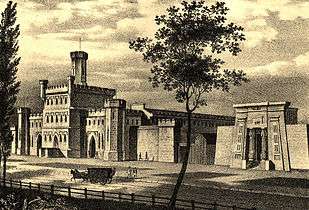Moyamensing Prison

Moyamensing Prison was a prison in Philadelphia, in the U.S. state of Pennsylvania. It was designed by Thomas U. Walter and completed in 1835. In use until 1963, it was demolished in 1968.[1]
History
The prison's cornerstone was laid April 2, 1832, and it was finished in 1835.[2] For nearly 140 years the Moyamensing, or New County, Prison dominated 1400 South 10th Street, at the southwest intersection with Passyunk Avenue and Reed Streets in South Philadelphia. It included a particularly fine Egyptian Revival wing. It was built to house 400 inmates, with a separate attached wing that would serve as a debtors' prison.[3] The Debtors' Apartment was built in this style in imitation of the Temple of Amenophis III, on the Isle d'Elephantine on the Nile.[4] But the Debtors' Apartment never served as such, as changes in law ended the imprisonment of debtors and the wing was combined with the main prison in 1868 and used to house women prisoners.[5]
Other than the Debtors' Apartment, most of prison was built in a castellated Gothic style with towers and battlements.[4] Its designer was Philadelphia architect Thomas Ustick Walter, who later designed the dome of the United States Capitol, and the United States Senate and United States House of Representatives wings of the Capitol as they exist today.
On July 1, 1849, when Edgar Allan Poe was in Philadelphia, he drank, became drunk and hallucinatory, and made a suicide attempt. He was detained for public drunkenness and incarcerated for one night in Moyamensing Prison.[6] No records exist which support this story other than Poe's own account of it.
While imprisoned here in 1855, abolitionist Passmore Williamson became a focus of the press, as northern publications spread his story throughout the country. Friends comfortably furnished his cell, and he received letters and several hundred visitors including both Frederick Douglass and Harriet Tubman.
On May 7, 1896, serial murderer H. H. Holmes was hanged at the prison.[7] Holmes' neck did not snap immediately; he instead died slowly, twitching over fifteen minutes before being pronounced dead twenty minutes after the trap was sprung.[8]
The prison was destroyed in 1968. Today, all that is left is a low heavy masonry stone wall remaining from the prison of the 1830s on the site along Reed Street.[2][9] An Acme Market sits on the site today.
References
- ↑ Pennsylvania Prison Society (1901). The Journal of Prison Discipline and Philanthropy. p. 10. Retrieved 2015-04-08.
- 1 2
- ↑ "Meara Welch Browne, P.C. - Certified Public Accountants". web.archive.org. Retrieved 2015-04-08.
- 1 2 "Egyptian Revivalism and Moyamensing Prison (Debtors’ Apartment) | NFR". ruins.wordpress.com. Retrieved 2015-04-08.
- ↑ "Egyptian Revivalism and Moyamensing Prison (Debtors’ Apartment) | NFR". ruins.wordpress.com. Retrieved 2015-04-08.
- ↑ Penn Libraries Edgar Allan Poe: 1849 Philadelphia, Pennsylvania and Richmond, Virginia
- ↑ H. H. Holmes: Master of Illusion
- ↑ "HOLMES COOL TO THE END - Under the Noose He Says He Only Killed Two Women. HE DENIES THE MURDER OF PIETZEL. Slept Soundly Through His Last Night on Earth and Was Calm on the Scaffold. PRIESTS WITH HIM ON THE GALLOWS. Prayed with Him Before the Trap Was Sprung -- Dead in Fifteen Min- utes, but Neck Was Not Broken. - Front Page - NYTimes.com". query.nytimes.com. Retrieved 2015-04-08.
- ↑